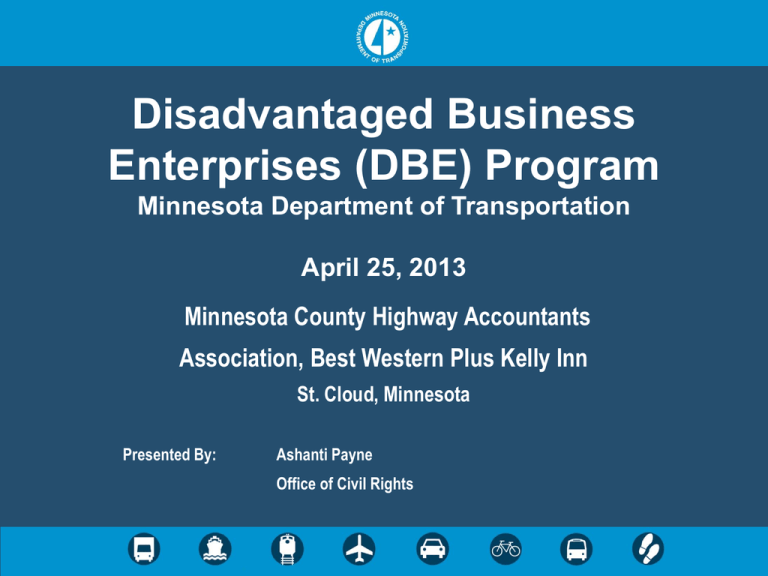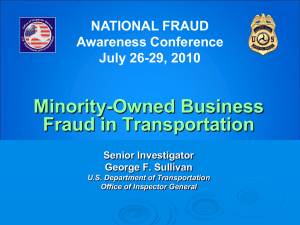
Disadvantaged Business
Enterprises (DBE) Program
Minnesota Department of Transportation
April 25, 2013
Minnesota County Highway Accountants
Association, Best Western Plus Kelly Inn
St. Cloud, Minnesota
Presented By:
Ashanti Payne
Office of Civil Rights
DBE Project Life-Cycle: Beginning to End
MnDOT’s Policy Statement
DBE Project goals (Planning) When do DBE goals apply?
When are they set within MnDOT’s procurement process?
How are goals set for projects?
Contract Clearance - Who is responsible for ensuring goals are
met?
Commercially Useful Function (CUF)
Counting DBE Credit/Trucking
Submitting a Responsible Bid (Good Faith Efforts)
The Good Faith Effort(GFE) review by DBE Specialist
Items which may be reviewed in assessing GFEs
DBE Project Life-Cycle (Cont.)
Reconsideration Process Contract Compliance (Post Award DBE Monitoring)
On-Site Reviews
Replacement of DBE’s
Prompt Payment
Contractor Payment Forms -
Final Payment Affidavit –
DBE Commitments vs. Payments
Policy Statement
It is the policy of the Minnesota Department of Transportation (MnDOT) that
DBEs, as defined in 49 C.F.R. Part 26, and other small businesses, shall
have the maximum feasible opportunity to participate in contracts
financed in whole or in parts with federal funds. Consistent with this
policy and Title VI of 1964 Civil Rights Act, MnDOT will not allow any
person or business to be excluded from participation in, denied the
benefits of, or otherwise be discriminated against in connection with the
award and performance of any U.S. Department of Transportation
(USDOT) assisted contract because of sex, race, color, or national origin.
MnDOT has established a Disadvantaged Business Enterprise (DBE)
program in accordance with the regulations of the DOT, 49 C.F.R. Part 26
to implement this policy.
Disadvantaged Business Enterprise (DBE)
Current Overall DBE Goal 10.3%
DBE participation on federally funded projects:
FHWA
2009 - 3.9%
2010 - 5.6%
Transit Projects
2009 – 0
2010 – 3.6%
2011 – 7.6% 2012 – 6.6%
2011 – 0%
2012 – 8.7%
DBE Project Goals – When do they apply? How and when
are they set? Who is responsible for compliance? What if
they are not met?
DBE Goals must be set on any contract(s) financed in whole or in
part with federal funds.
We review the following when setting goals on any given project on
a case by case basis; [project location, project size, sub
contracting opportunities, work types & availability (ready, willing
& able) of DBEs]
Ultimately the Prime Contractors are held to meet the goals
identified on the project. However, it is the responsibility of all
subs to work closely with the Prime in meeting those goals.
What happens if a goal is not met at the time one is set;
What happens if a goal is not met throughout the monitoring of the
project;
Goal Setting Protocol:
Step One – Office of Civil Rights (OCR) receives required
information from District Office and Special Provisions Engineer
Project Breakdown
Scopes of Work
Cost Estimate
Advertisement Date
Letting Date
Anticipated Start
Working Days
Any Pertinent Project-related Information
Goal Setting Protocol (Cont.):
Step Two – Identifying Scopes of Work DBE’s Can perform
Bituminous (Pavement, Sawing, Mill, Seal Coats, etc.)
Concrete (Bridge, Pavement, Sawing, etc.)
Electrical (Supplies Installation, Signals, etc.)
Excavation (Clear & Grub, Demolition, Removal of Curb & Gutter, etc.)
Fencing (Ornamental, Wire, Chain, Wood, Guardrails, etc.)
Landscaping (Mulching, Silt fence, Erosion Control, etc.)
Pavement Marking (Interim, Removal, Epoxy, etc.)
Materials (Aggregate, RipRap, Oil, etc.)
Misc. (Utilities, Drainage, Painting
Planning (Traffic Control, Signing, Surveying, Consulting, etc.)
Goal Setting Protocol (Cont.):
Step Two (Cont.) – Identifying Scopes of Work DBE’s Can
perform
Sewer (Installation, RC Pipe, Irrigation, etc,)
Rebar/Steel (Installation, Erection, Placement, etc.)
Trucking (Grading, Hauling, etc.)
Walls (Noise, Retaining, etc.)
Other (Any other scopes that may be a part of THIS project)
Goal Setting Protocol (Cont.):
Step Three – Arriving at an “Overall” DBE Project Goal
How is it done?
What is the Purpose?
Step Four – Exclusion of Scopes of Work
Why?
What are the key factors to consider when excluding work
Step Five – Establishing a final Project Goal
Goal Setting Protocol (Cont.):
Step Six – Final Approval and Signature from OCR Director
Step Seven – DBE Project Goal is sent to MnDOT Special
Provisions Engineer
Step Eight – Project is advertised according relevant schedule
and appropriate Letting
Goal Setting Protocol (Cont.):
Questions?
Contract Clearance:
Meet The Established Goal On The Project!!!!!
• Meet the DBE goal on a project or demonstrate Good Faith
Efforts.
• The bidder must show that it took all necessary and reasonable
steps to achieve a DBE goal or other requirements of 49 C.F.R.
Part 26 which, by their scope, intensity, and appropriateness to
the objective, could reasonably be expected to obtain sufficient
DBE participation. (49 C.F.R. §26.53)
Contract Clearance (Cont.):
Goal Is Met
Commercial Useful Function (CUF)
DBE firms must perform at least 30% of subcontract
§ 26.55
(1) A DBE performs a commercially useful function when it is responsible for execution of the work of the contract and is carrying out its
responsibilities by actually performing, managing, and supervising the work involved. To perform a commercially useful function, the DBE
must also be responsible, with respect to materials and supplies used on the contract, for negotiating price, determining quality and
quantity, ordering the material, and installing (where applicable) and paying for the material itself. To determine whether a DBE is
performing a commercially useful function, you must evaluate the amount of work subcontracted, industry practices, whether the amount
the firm is to be paid under the contract is commensurate with the work it is actually performing and the DBE credit claimed for its
performance of the work, and other relevant factors.
(2) A DBE does not perform a commercially useful function if its role is limited to that of an extra participant in a transaction, contract, or project
through which funds are passed in order to obtain the appearance of DBE participation. In determining whether a DBE is such an extra
participant, you must examine similar transactions, particularly those in which DBEs do not participate.
(3) If a DBE does not perform or exercise responsibility for at least 30 percent of the total cost of its contract with its own work force, or the DBE
subcontracts a greater portion of the work of a contract than would be expected on the basis of normal industry practice for the type of work
involved, you must presume that it is not performing a commercially useful function.
Contract Clearance (Cont.):
Bottom Line – MnDOT OCR must determine the value of the
work actually performed by the DBE(s) with their own equipment
and forces in order to apply it towards the DBE Goal.
Forms (Assist OCR in the determination)
Exhibit A’s
Bidders List
Advertisements and Quotes
Counting DBE Credit/Trucking (Cont.):
§ 26.55 How is DBE participation counted toward goals?
(a) When a DBE participates in a contract, you count only the value of the work actually performed by the DBE
toward DBE goals.
(1) Count the entire amount of that portion of a construction contract (or other contract not covered by paragraph
(a)(2) of this section) that is performed by the DBE's own forces. Include the cost of supplies and materials
obtained by the DBE for the work of the contract, including supplies purchased or equipment leased by the
DBE (except supplies and equipment the DBE subcontractor purchases or leases from the prime contractor or
its affiliate).
(2) Count the entire amount of fees or commissions charged by a DBE firm for providing a bona fide service, such
as professional, technical, consultant, or managerial services, or for providing bonds or insurance specifically
required for the performance of a DOT-assisted contract, toward DBE goals, provided you determine the fee to
be reasonable and not excessive as compared with fees customarily allowed for similar services.
(3) When a DBE subcontracts part of the work of its contract to another firm, the value of the subcontracted work
may be counted toward DBE goals only if the DBE's subcontractor is itself a DBE. Work that a DBE
subcontracts to a non-DBE firm does not count toward DBE goals.
(b) When a DBE performs as a participant in a joint venture, count a portion of the total dollar value of the contract
equal to the distinct, clearly defined portion of the work of the contract that the DBE performs with its own
forces toward DBE goals.
Counting DBE Credit/Trucking (Cont.):
§ 26.55
d) Use the following factors in determining whether a DBE trucking company is performing a commercially useful function:
(1) The DBE must be responsible for the management and supervision of the entire trucking operation for which it is responsible
on a particular contract, and there cannot be a contrived arrangement for the purpose of meeting DBE goals.
(2) The DBE must itself own and operate at least one fully licensed, insured, and operational truck used on the contract.
(3) The DBE receives credit for the total value of the transportation services it provides on the contract using trucks it owns,
insures, and operates using drivers it employs.
(4) The DBE may lease trucks from another DBE firm, including an owner-operator who is certified as a DBE. The DBE who leases
trucks from another DBE receives credit for the total value of the transportation services the lessee DBE provides on the
contract.
(5) The DBE may also lease trucks from a non-DBE firm, including from an owner-operator. The DBE who leases trucks from a
non-DBE is entitled to credit for the total value of transportation services provided by non-DBE lessees not to exceed the
value of transportation services provided by DBE-owned trucks on the contract. Additional participation by non-DBE
lessees receives credit only for the fee or commission it receives as a result of the lease arrangement. If a recipient
chooses this approach, it must obtain written consent from the appropriate Department Operating Administration.
Example to this paragraph (d)(5): DBE Firm X uses two of its own trucks on a contract. It leases two trucks from DBE Firm Y and
six trucks from non-DBE Firm Z. DBE credit would be awarded for the total value of transportation services provided by
Firm X and Firm Y, and may also be awarded for the total value of transportation services provided by four of the six trucks
provided by Firm Z. In all, full credit would be allowed for the participation of eight trucks. With respect to the other two
trucks provided by Firm Z, DBE credit could be awarded only for the fees or commissions pertaining to those trucks Firm X
receives as a result of the lease with Firm Z.
Counting DBE Credit/Trucking (Cont.)
(e) Count expenditures with DBEs for materials or supplies toward DBE goals as provided in the following:
(1)(i) If the materials or supplies are obtained from a DBE manufacturer, count 100 percent of the cost of the materials or supplies
toward DBE goals.
(ii) For purposes of this paragraph (e)(1), a manufacturer is a firm that operates or maintains a factory or establishment that produces,
on the premises, the materials, supplies, articles, or equipment required under the contract and of the general character
described by the specifications.
(2)(i) If the materials or supplies are purchased from a DBE regular dealer, count 60 percent of the cost of the materials or supplies
toward DBE goals.
(ii) For purposes of this section, a regular dealer is a firm that owns, operates, or maintains a store, warehouse, or other establishment
in which the materials, supplies, articles or equipment of the general character described by the specifications and required
under the contract are bought, kept in stock, and regularly sold or leased to the public in the usual course of business.
(A) To be a regular dealer, the firm must be an established, regular business that engages, as its principal business and under its own
name, in the purchase and sale or lease of the products in question.
(B) A person may be a regular dealer in such bulk items as petroleum products, steel, cement, gravel, stone, or asphalt without
owning, operating, or maintaining a place of business as provided in this paragraph (e)(2)(ii) if the person both owns and
operates distribution equipment for the products. Any supplementing of regular dealers' own distribution equipment shall be by
a long-term lease agreement and not on an ad hoc or contract-by-contract basis.
(C) Packagers, brokers, manufacturers' representatives, or other persons who arrange or expedite transactions are not regular dealers
within the meaning of this paragraph (e)(2).
(3) With respect to materials or supplies purchased from a DBE which is neither a manufacturer nor a regular dealer, count the entire
amount of fees or commissions charged for assistance in the procurement of the materials and supplies, or fees or
transportation charges for the delivery of materials or supplies required on a job site, toward DBE goals, provided you determine
the fees to be reasonable and not excessive as compared with fees customarily allowed for similar services. Do not count any
portion of the cost of the materials and supplies themselves toward DBE goals, however.
Counting DBE Credit/Trucking (Cont.)
Mentor Protégé Arrangement(s)
May be used to fulfill part or all of the DBE goal
Formal Arrangement(s)/Agreement(s)
Prior Approval from MnDOT Office of Civil Rights
Includes both DBE Protégé and Mentor
§ 26.55
(b) When a DBE performs as a participant in a joint venture, count a portion of the total
dollar value of the contract equal to the distinct, clearly defined portion of the work of
the contract that the DBE performs with its own forces toward DBE goals.
Contract Clearance:
If everything adds up – The Project is cleared for Award and gets built:
- On Time
- On Budget
Discussion/Questions?
Submitting A Responsible Bid/Good Faith Effort (GFE)
Good Faith Efforts - Forms
Narrative
a letter explaining in detail the efforts the ALB made to meet the
DBE goal
Exhibit A
Certificate of Good Faith Efforts Consolidated
Form
Bidders List
Good Faith Efforts Affidavit
GFE Materials must be submitted within five (5) business days
after notification of being the Apparent Low Bidder (ALB)
Submitting A Responsible Bid/GFE (Cont.)
MnDOT Office of Civil Rights Evaluation – 5 Key Factors:
I. Solicitation
II. Negotiation
III. Assistance (Materials, Supplies, Plans, Bonding, etc.)
IV. Breaking out Portions of Work Being Self-performed
V. De-bundling
Reconsideration Process
Post Award DBE Monitoring
Post Award
On-Site Reviews
Monitoring DBE Field Work- Exhibit A.
Competed/executed by DBE Principal
DBE resources & Capacity (i.e, people, equipment, etc.)
DBE subcontractors- Controlling own work, using own resources & doing the
work
Consistent with Exhibit A
Replacement of DBE’s
Contractor Payment Form
Complete, Consistent, Accurate
Final Payment Affidavit
Standard Specifications for Construction, Section 1908:
A Contractor must submit a Final Payment Affidavit showing amounts paid to a DBE before final payment can be
made on a project.
Affidavit must be approved by OCR before final payment.
Affidavit sent to Project Engineer & the Office of Civil Rights.
Contractor Payment Form
Contract Number:
Agency/Grantee/Consultants/Subcontractor:
Payment Reporting Period:
Instructions:
From:
To:
All Agencies/Grantees/Consultants/Subcontractors making payments to Contractors/Subcontractors/Suppliers/Service Providers, regardless of their tier or DBE status, are required to
complete and submit this form to the Mn/DOT Office of Civil Rights (OCR), until final payment is made. Failure to comply with this form, and Minnesota’s prompt payment law may
cause progress payments to the Design-Builder’s to be withheld. Submit one copy of this form to the Mn/DOT OCR and one copy to the Office of Transit Grant Manager, no later than
ten (10) days after receiving payment from Mn/DOT.
Agency/Grantee/Subcontractor Information
Original Contract Amount
Committed DBE %
Actual DBE % to Date
Name:
Address:
Phone:
Name of Subcontractor/Supplier
DBE?
(Check if
Yes)
Description of Work
Subcontract Amount
1.
1.
1.
2.
2.
2.
3.
3.
3.
4.
4.
4.
5.
5.
5.
Amount of Current Payment
% Paid to date
Final Payment? Yes/No
1.
1.
1.
2.
2.
2.
3.
3.
3.
4.
4.
4.
5.
5.
5.
Company Officials Signature & Title
Date Signed
Name & Title of Individual Completing Report
(Type or Print Clearly)
Title:
Title:
Phone:
Fax:
This form may be submitted in an alternate format
DBE Total Payment Form
Minnesota Department of Tra nspo rtation
Office of Civil Rights
DBE Total Payment Affidavit
Pursuant to Mn/DOT Standard Specifications for Construction, Section 1908, the following DBE Total Payment Affidavit
shall be executed by the Prime Contractor after all work has been performed by a DBE on this project.
Contract Number:
State of:
County of
I,
, being first duly sworn, do depose and say that
(Authorized Representative)
1. I am the authorized representative of
(Name of Individual Company, Partnership or Corporation)
and I have the authority to make this Affidavit for and on behalf of said Prime Contractor.
2. The following DBE Subcontractors/Suppliers/Service Providers/Sub-Consultants have performed work on
this contract/project with a total dollar value of:
Dollar Amount of
Total Dollar Amount
Name of DBE Firm
Subcontract
Paid DBE
1.
2.
3.
3. If the dollar value of the DBE firm’s total work is less than the DBE’s original subcontract/agreement, please explain:
4. I have fully informed myself regarding the accuracy of the statements made in this Affidavit.
Signed:
(Prime Contractor or Authorized Representative)
Subscribed and sworn to before me.
This
day of
, 20
Notary Seal
(Notary Public)
My commission expires
, 20
Prepare Affidavit in duplicate. Submit one original to
the Project Engineer, and one original to:
Mn/DOT Office of Civil Rights
395 John Ireland Blvd., MS 170
St. Paul, MN 55155
No. 1908 – Standard Specifications fo r Construction
Unless the Contractor has presented an Affidavit
showing the total dollar amounts of work performed by
Disadvantaged Business Enterprises (DBE), final
payment may be withheld.
DBE Commitments vs. Payments
What Does This Mean?
Don’t Forget
Your Responsibilities
Fulfill DBE Commitment
Prompt Payment
DBE Replacement
Award of Contract (After receiving clearance letter)
Exhibit A submittal.
Trucking Guidelines
EEO Office Responsibilities
Good Faith Affidavit
Certificate of Good Faith Efforts
Bidders List
Contractor Payments
Contract Clearance (timely mannered, 3-5 days)
MnDOT Office of Civil Rights
Small Business Contracting Section, Supervisor
Ashanti Payne
ashanti.payne@state.mn.us
651-366-3071
DBE Specialists
Andrea Robinson (East Metro)
andrea.robinson@state.mn.us
651-366-3353
Cole Busch (MnDOT Districts 1,2,3,4) cole.busch@state.mn.us
651-366-3332
Sheila Scott (MnDOT Districts 6,7,8) sheila.scott@state.mn.us
651-366-3323
Terrina White-Vasser (West Metro)
651-366-3074
terrina.white-vasser@state.mn.us
Targeted Group Business (TGB) and Veterans Programs
Michael Johnson (Team Lead)
michael.allan.johnson@state.mn.us
Joyce Brown-Griffin (TGB Specialist) joyce.brown-griffin@state.mn.us
Michelle Reynolds (Veterans Specialist)
651-366-3329
651-366-3350
michelle.reynolds@state.mn.us
651-366-3335
DBE Administration Contact
Diane Clark
diane.clark@state.mn.us
651-366-4290
Heidi Audette
heidi.audette@state.mn.us
651-366-3328
http://www.dot.state.mn.us/civilrights/index.html










